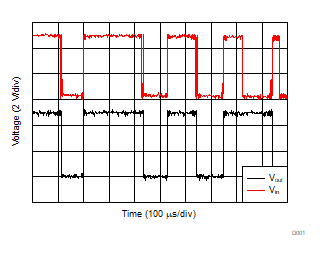SCLS263R December 1995 – October 2023 SN54AHCT74 , SN74AHCT74
PRODMIX
- 1
- 1 Features
- 2 Applications
- 3 Description
- 4 Revision History
- 5 Pin Configuration and Functions
- 6 Specifications
- 7 Parameter Measurement Information
- 8 Detailed Description
- 9 Application and Implementation
- 10Device and Documentation Support
- 11Mechanical, Packaging, and Orderable Information
Package Options
Refer to the PDF data sheet for device specific package drawings
Mechanical Data (Package|Pins)
- D|14
- RGY|14
- DB|14
- DGV|14
- PW|14
- BQA|14
- N|14
- NS|14
Thermal pad, mechanical data (Package|Pins)
Orderable Information
9.2.3 Application Curves
Figure 9-2 shows an example of a single button press bouncing and causing the output to toggle multiple times. This will cause issues in the desired application. Figure 9-3 shows 4 button presses with an added debounce circuit, fixing the unwanted toggling and allowing for proper toggle switch operation.
 Figure 9-2 Circuit Response Without RC Debounce
Figure 9-2 Circuit Response Without RC DebounceVin: = CLK Input, Vout := Q Output
 Figure 9-3 Circuit Response with RC Debounce Vin: = CLK Input,
Vout := Q Output
Figure 9-3 Circuit Response with RC Debounce Vin: = CLK Input,
Vout := Q Output